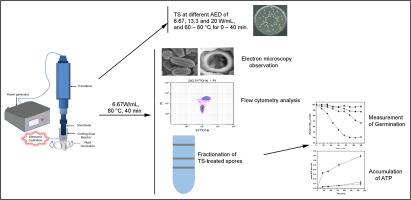Food Research International ( IF 7.0 ) Pub Date : 2018-10-09 , DOI: 10.1016/j.foodres.2018.09.052 Lihua Fan , Furong Hou , Aliyu Idris Muhammad , L.V. Ruiling , Ritesh Balaso Watharkar , Mingming Guo , Tian Ding , Donghong Liu

|
Some Bacillus species are causative agents of food spoilage and a wide array of diseases. Due to their ability to form highly heat-resistant spores, it is of great interest to develop more effective inactivation strategies whereby these spores could be inactivated. Therefore, this work assessed inactivation of thermal and ultrasound treatments against Bacillus subtilis spores. The study further investigated the thermosonication (thermal and ultrasound, TS) -induced inactivation to the spores through a combination of morphology observation and internal factor analyses. The results of TS indicated that the TS combination synergistically inactivated spores by the maximum log reduction of 2.43 ± 0.08 at 80 °C and 20 W/mL and caused severe cell damage. The visual images revealed that the destructive mode of action of TS had multitarget sites, including coat, cortex, and inner membrane. Three distinct sub-populations were detected by Flow cytometry (FCM), and an unknown step with some physical compromise of the spore's inner membrane and partially hydrolyzed cortex involving the three steps model of inactivation was suggested. The combination of DPA (pyridine-2,6 dicarboxylic acid) content and the relative viabilities of the fractions suggested that during the TS treatment DPA release took place largely after spore death. The dead spores that retained DPA germinated relatively normally, but outgrow poorly, indicating that some key enzymes of intermediary metabolism has been damaged by TS treatment. Such understanding of the lethal action of TS may lead to the development of novel strategies involving spore destruction.
中文翻译:

热和超声处理枯草芽孢杆菌孢子的协同失活及其机理
一些芽孢杆菌属是导致食物变质和多种疾病的诱因。由于它们能够形成高度耐热的孢子,因此开发更有效的灭活策略以使这些孢子失活具有极大的兴趣。因此,这项工作评估了针对枯草芽孢杆菌的热疗法和超声疗法的灭活作用。孢子。该研究通过形态观察和内部因素分析相结合,进一步研究了热超声处理(热和超声,TS)引起的孢子失活。TS的结果表明,在80℃和20W / mL下,TS组合通过2.43±0.08的最大对数减少来协同灭活孢子,并引起严重的细胞损伤。视觉图像显示,TS的破坏性作用模式具有多个目标部位,包括皮毛,皮层和内膜。通过流式细胞仪(FCM)检测到三个不同的亚群,并提出了一个未知步骤,该步骤涉及孢子内膜和部分水解皮层的一些物理折衷,涉及失活的三个步骤模型。DPA(吡啶2,6个二羧酸的含量和各部分的相对生存力表明,在TS处理期间,DPA的释放主要发生在孢子死亡后。保留了DPA的死孢子相对正常地发芽,但生长较差,表明TS处理破坏了一些中间代谢的关键酶。对TS的致死作用的这种理解可能导致涉及孢子破坏的新策略的发展。











































 京公网安备 11010802027423号
京公网安备 11010802027423号